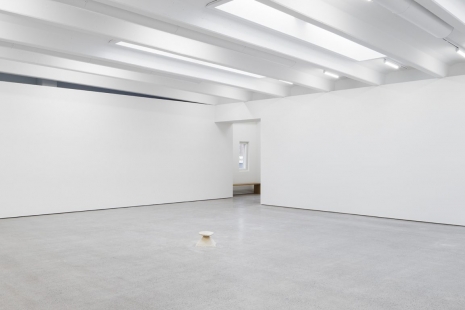Hans Rosenström (Finland, 1978, lives in Stockholm) is well known to art audiences in Finland for experiential installations that feature sound, voice and language, and also light, props and built environments. They may be more or less temporary (when they happen in galleries and museums) or permanent (for instance in the new Espoonlahti metro station, yet to be inaugurated). Rosenström also co-curated the exhibition ’A I S T I T / coming to our senses’ at Kusthalle Helsinki last summer, and he is a member of the Kohta Council.
Evanesce (2022) is a new piece devised for Kohta’s larger exhibition space. Lengths of light-weight white fabric hang from the ceiling. They form a porous and semi-permeable labyrinth alluding to the construction and consistency of the human body. Although each layer of fabric is thin and quite transparent, the view from inside becomes a milky whiteness. Visitors may choose different routes to reach the centre but must eventually exit through the entrance. That is the very definition of a labyrinth. This one also brings to mind the convoluted architecture of the human ear.
The four-channel sound component of the installation is a composition for five voices. Three of them can be constantly heard ‘from within the gallery walls’, wordlessly singing and making faint but vaguely unsettling noises. The other two do have language to offer, a short redoubled monologue in English, but are only released from silence when visitors reach the centre of the labyrinth and set off a sensor controlling two loudspeakers perched on tripods: ‘Listen to this soft pulse rising from my chest, escaping through the mouth…’
The verb ‘evanesce’ is in fact reverse-engineered from the adjective ‘evanescent’ and denotes the action or state of ‘vanishing by degree, melting into thin air’. To contextualise this work, Hans Rosenström writes:
‘A voice is, and then it is no more. I see the voice as an extension of the self, shaped inside the body. Its immateriality enables it to float from one core to another. When we speak we are not just hoping to communicate but actually invading other bodies, affecting others in ways that we ourselves can never know.’
Tõnis Vint (Estonia, 1942–2019) was one of the leading characters in the unofficial art scene that somehow managed to exist in Tallinn from the 1960s until the end of the Soviet occupation of Estonia. He was a graphic artist in the fullest sense: not just a draughtsman, printmaker, magazine and book designer but a visionary creator of total works of art in black and white (and occasionally red and other colours).
In Vint’s work, the flatness of the drawn or printed paper is just a temporary limitation to be overcome by ‘a new type of organisation for the entire human environment’. This ‘psycho-geometric method’ was particularly well manifested in his flats, legendary meeting places for Estonia’s visual arts intelligentsia (and frequent guests from the colonial metropolises of Moscow and Leningrad) from the late 1960s onwards. The first one, in the suburb of Mustamäe, was decorated in exquisite, predominantly white, Japanese style. The second one, in the city centre, will now become a museum of his art and his equally important legacy as a writer and teacher (notably his long-time tutoring of the artist group Studio 22). It was decorated in exquisite, predominantly black, Chinese style in the early 1980s.
Another example of Vint’s ‘psycho-geometric method’ is his design for the journals Kunst (Art) from 1971 to 1977 and Kultuur ja Elu (Culture and Life) from 1973 to 1980, or for the anthology Teadus ja Tänapäev (Science and Today), published in 1979. With such publications he managed, despite Soviet censorship and poor printing, to create Gesamtkunstwerke for the late twentieth century. He also designed theatrical sets and whole urban environments.
Most of Vint’s extensive oeuvre is simultaneously industrial and spiritual, spontaneous and self-regulated. We sense these characteristics already in the ink drawings he started making, in rather small formats, in the mid-1960s.
Kohta is pleased to be able to show a generous selection of these early works in collaboration with the artist’s widow Eva Vint and with Temnikova & Kasela Gallery in Tallinn, which recently exhibited a very similar selection under the same title, ‘Guided Randomness’. We are grateful to them.
Eva Vint and Elnara Taidre, curator at the Kumu Art Museum in Tallinn, have also edited a lavishly illustrated selection of Tõnis Vint’s essays on what today would be called visual culture (Tõnis Vint: Kogutud artiklid/Collection of Articles. Tallinn: ;paranoia publishing group ltd, 2021), which will be available for purchase at Kohta.





